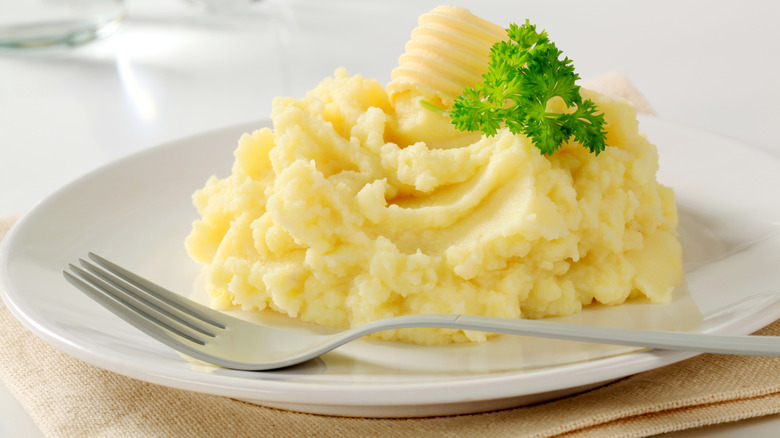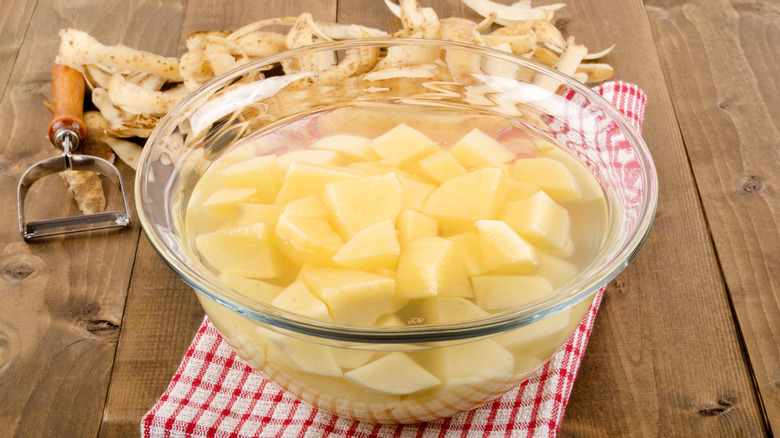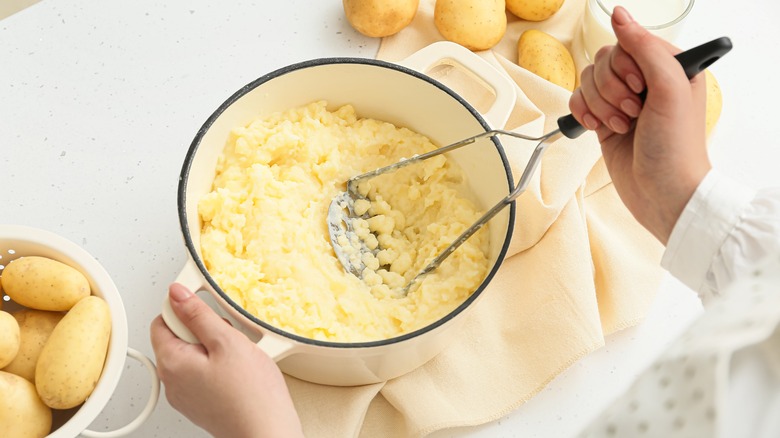The Step You Shouldn't Skip For The Fluffiest Mashed Potatoes
There are lots of tasty ingredients that can change the way you make mashed potatoes, but one of the best additions to your recipe is readily available in most home kitchens: ice water. We're not telling you to mix cold water into your mash; rather, you can use it to prepare the cut potatoes for fabulously fluffy results.
Soaking the peeled and cut tubers in ice water to remove excess starch is a simple step that ensures a light, fluffy mash instead of a dense one. It's a technique you might have done before when rinsing rice or soaking potatoes to make french fries. Potatoes and grains are naturally starchy, but too much starch — more specifically, a kind called amylose — can lead to a sticky or gummy texture in your final dish. Removing some of it via rinsing or soaking leads to fluffy rice, fries, and yes, mashed potatoes.
Incidentally, you should also start cooking the spuds in cold water instead of dumping them into an already-boiling pot, which is a common mistake to avoid when making mashed potatoes. Putting them in a pot of cold water and bringing it up to a boil helps the taters cook evenly and develop a better texture, without becoming lumpy when mashed.
How to soak potatoes for a fluffy mash
The reason cold water is best for soaking potatoes is because the heat from hot water can actually activate the spuds' starches, defeating the purpose of the step. Ice ensures that the water stays extra-cold for the entire soaking period. To try this trick, you need to peel and evenly dice the potatoes into one-inch pieces, which is small enough to provide plenty of surface area for the starches to leach out. Place the pieces in a large bowl of water with a handful of ice cubes. Let the spuds soak for at least half an hour, or a whole hour for even better results.
As the excess starch begins to wash out, you'll notice the water turning a milky white color. Once the time is up, carefully scoop the tubers out, so as not to disturb the starches that have collected at the bottom of the bowl. Rinse the spuds again to remove any lingering starch, then proceed with your recipe.
If you don't have any ice on hand, or you don't have the time to wait for the potatoes to soak, you can achieve a similar effect by rinsing the cut taters under cold running water in a bowl. Just hold the bowl under the tap for a few minutes, drain, and repeat until the water runs clear. Your mash should still end up fluffier than it normally would be.
You can soak potatoes in advance to prep ahead
If you're making mash for a crowd, or you like to get prep work done in advance for dinner, the good news is that you can start this soaking step over an hour in advance. In fact, you can even do it overnight, provided that you cover the bowl of potatoes and water well and then store it in the fridge. This also happens to be a great tip for storing peeled potatoes without excess browning.
Although the ice cubes in the water will melt over time (unless you have a super cold fridge), they'll still keep the water nice and chilled. The spuds can safely soak for up to 24 hours in the refrigerator. Then, all you have to do is take the bowl out of the fridge and get to cooking and mashing. Making mashed potatoes from scratch for a quick weeknight dinner will actually seem doable with this trick.
For a final few tips, it's important to choose the right potatoes for a fluffy versus creamy mash, so go for a variety like russets or Idaho potatoes to ramp up the fluff factor even further. And although you can mash by hand, a ricer is the best tool for mashing potatoes if you want the most professional-looking result. It creates a light, fluffy, lump-free mash without overworking the potatoes, a mistake that produces gummy and sticky results.



